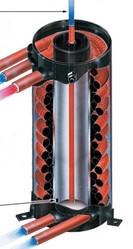
|
The refrigerant circuit is a closed loop heat transfer circuit in any refrigeration device. The compressor is a device that compresses and pumps the refrigerant first to the condensing coil to reject the heat energy and in doing so the refrigerant condenses to a liquid state. The liquid refrigerant continues in the loop to the indoor evaporator coil. The refrigerant is routed through a metering device that allows the refrigerant to change state and flash from a liquid to a super cooled gas that absorbs heat in the evaporator coil from the indoor air stream. As the heat is removed from the air stream the air returns to the space cooler and dryer. The gas then completes the journey from the evaporator back to the compressor to be compressed and complete the cycle over and over. |
|
There several applications and designs now utilizing a water cooling tower to subcool the refrigerant in both commercial and residential. Some are called hybrid cooling towers, these use Freon/Water Heat Exchangers to achieve the same concept. Normally designed to used a swimming pool to cool the home and extend the seasons swimming pleasure. Several are designed to retro fit to existing commercial HVAC Roof top Units. By keeping the Roof Top Air Cooled unit in place and adding an Evaporative Fluid cooling tower the water cooled travels to the roof top unit and the heat exchange is made by a unit call refrigerant/water heat exchanger. This same tower can be used to subcool several units and the buildings refrigeration at one time. Saving even greater energy consumption. |
|
In the commercial market there are thousands of the “one size fits all” HVAC roof top units operating today. Water cooled air conditioner technology has been used in larger buildings and industrial sites for years, but now there are new water cooling towers designed to address the already existing Roof Top Units on smaller buildings. |
|
Evaporative Fluid Cooling, Evaporative Condenser Cooling, and Evaporative Subcooling towers all use water to cool the refrigerant in a closed loop design. The only difference in the towers is the coil design required by application. The Evaporative Water Cool Air Conditioning Retro Fit technology is saving energy by reducing consumption and lowering carbon footprint. |
|
Water Cooled Air Condition using an Evaporative Cooling tower removes additional heat from the refrigerant circuit by sub-cooling; the pressures drop, the capacity increases, and the compressor uses less electricity. Reducing consumption gains energy savings. Subcooling the refrigerant used in air conditioning and refrigeration offers huge savings in light commercial and box style buildings with air roof top units and roof top refrigeration compressors. |
|
Sub-cooling increases the system's efficiency by reducing compressor power and increasing the system's refrigeration process. Sub-cooling decreases the amount of energy that is required to operate a refrigeration system and, therefore, realizes a cost savings to the user. A rule of thumb is that for every two degrees of sub-cooling, the system operating cost is reduced by one percent . |
|
The evaporative fluid cooling tower cools the Water or Freon below the temperature of the ambient air. The evaporative effect of phase change removes heat from the water down to with in a few degrees of the “wet bulb” temperature. The wet bulb temperature is the temperature that can be achieved by evaporating water. The hotter the day the dryer the air, more heat equals less moisture in most parts of the country. So the dryer the air the better (cooler) the evaporative effect is, and this lower temperature can be as much as 40 to 50 degrees colder than the ambient temperature in many parts of the desert southwest. However evaporative effect will always result in lower temperatures than the ambient conditions. |
|
All refrigerant gasses respond in a similar pressure/temperature relationship, more heat equals more pressure. More pressure equals more energy used. By removing additional heat from the refrigerant circuit via evaporative sub-cooling the pressures drop, the capacity increases, and the compressor uses less electricity. |
|
Water is used to sub-cool liquid refrigerant after it leaves the condenser and energy savings vary depending upon condensing and evaporator temperatures of the refrigeration system. Due to theses physical dependencies, each refrigeration system must be evaluated on its own application, but this technology has proven to reduce consumption and save money. |
|
Evaporative Subcooling |

